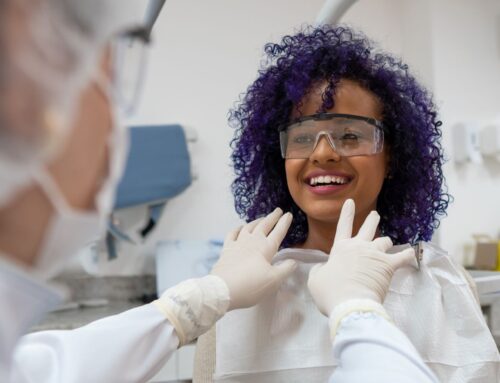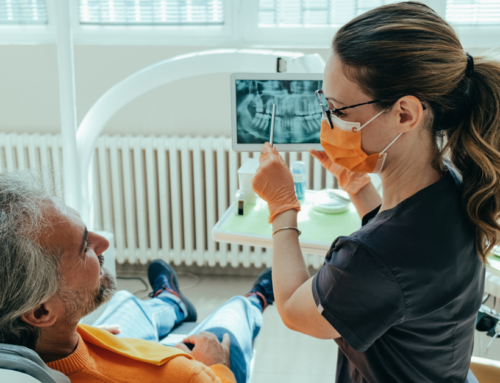What Is An Impacted Tooth And How Is It Fixed?
Many of us might not know exactly what an impacted tooth is, but just the very sound of the term has a way of setting our teeth on edge. In dentist speak, an impacted tooth is one that hasn’t passed through the gum line into a position of its own. The tooth is stuck — or impacted — in the gum tissue or bone. In nontechnical terms, it’s a pain in the, well, mouth — quite literally.
Impacted teeth can happen for multiple reasons and it’s important to understand exactly what constitutes an impacted tooth, why you should see a dental expert, and how a dentist or oral surgeon can fix that sucker for good.
We’re here to walk you through the process, and we promise to make you feel as comfortable as possible about the idea of an impacted tooth, so that you won’t feel like you’re going through something akin to a root canal.
What Is An Impacted Tooth?
Both orthodontists and dental specialists will tell you that an impacted tooth is when the tooth has not come in — or erupted — as it was supposed to because it doesn’t have enough room to “sprout” (okay that’s not exactly the medical term), or it may be coming up in the wrong direction or position.
It’s a mystery even to dentists why a tooth doesn’t come in the way that it should — it’s one of those things that just happens in life. Although feel free to blame genetics as one possible culprit: if a parent had an impacted tooth, there is a chance that their child may be affected by the same oral issue.
Wisdom Teeth Can Have It The Worst
When it comes to impacted teeth, the wisdom teeth tend to carry most of the burden. Older teenagers or adults are often affected by impacted wisdom teeth the most. If a wisdom tooth becomes stuck below the surface of your gums and happens to grow at an odd angle, there is a chance that it can create some complications. More specifically, impacted wisdom teeth are the third molars at the back of the mouth that don’t have enough room to fully come or develop normally.
Many of us are aware of how painful wisdom teeth can be, but they can also damage other teeth and cause other dental problems. In some cases, impacted wisdom teeth might not even cause any issues at all. While that sounds like a problem we can happily ignore, wisdom teeth can be difficult to clean, and they can also be more susceptible to tooth decay and gum disease compared to other teeth.
Other Teeth Can Be Impacted, Too
While wisdom teeth are certainly more susceptible, our other teeth aren’t immune: dental experts say that the second most common teeth to be impacted are the maxillary canines — also referred to as the cuspid or eye teeth. Cuspid teeth are the ones found on both the upper and lower jaws between the incisors (your flat front teeth), and the premolars (your small chewing teeth). If that sounds like a mouthful, a cuspid is the third tooth to the left or right of centre when you smile.
Since your cuspid teeth are much more functional than your wisdom teeth, your dentist is more likely to recommend a treatment that will encourage these teeth to erupt instead of removing them.
Some Signs and Symptoms That You May Have An Impacted Tooth
So what should you look — or rather feel for — when it comes to an impacted tooth? Red or swollen gums is one red flag. Tender or bleeding gums could also very well be a sign. You might have swelling around the jaw pain or feel pointed jaw pain itself. You might also have difficulty opening your mouth. Bad breath could even be a sign that you have an impacted tooth as well as an unpleasant taste in your mouth.
Assessing The Impact
If you feel that you’re experiencing any or all of the above symptoms, make sure to make an appointment with your dentist right away. It’s very important to treat an impacted tooth to help prevent the improper eruption of nearby teeth, cyst formation, possible infection, or any other negative impact in the jaw.
To get a grasp on the correct treatment option for you, your dentist will examine your teeth and you’ll get a round of radiographs to determine the exact position of the impacted tooth as well as the condition of your gums.
What Happens If You Try To Escape The Impact?
We have to add this section in because we know after all this reading, an escape plan may have entered your mind (even if for just a second!). While we do understand the trepidation, we’re here to tell you that it won’t look good if you decide to go down that road. In other words, what happens if an impacted tooth isn’t removed? There’s no two ways about it: you might have to deal with the dreaded gum disease. Not only is there a good chance that you’ll develop tooth decay, but the difficulty of cleaning impacted, partially erupted wisdom teeth increases the risk of developing a painful, inflammatory gum condition called pericoronitis. This can lead to pain and swelling in or around the tooth, jaw or cheeks, and will likely continue to recur if not treated. So let’s not even think about the escape plan as a possibility.
Some Options On The Table
Your dentist will recommend one of a few options to bring the impact down. One possible line of treatment is to surgically expose the tooth in order to guide it to the right position in your jaw. In most cases, you will need to have space created in your jaw through orthodontics prior to the surgical treatment. Once the surgery is over, your dentist may want to place a protective dressing over the surgical site while it heals. This will help the canine tooth to emerge until it is at the level of the adjacent teeth, at which point the teeth can be aligned with braces.
Another option — referred by dental experts as a closed technique — is that after the dentist exposes the tooth, he or she will attach a bracket to it and then replace your gums back to their original position. The orthodontic wire will be visible through your gums while the tooth is guided to its proper position, but it’s a small price to pay to get your teeth aligned and back in order.
Once your orthodontic treatment is completed, minor recontouring of your gums may be necessary.
One more treatment option could be that your dentist will create a window through the gums to the surface of the tooth. He or she will then attach an orthodontic bracket to the tooth to help guide it to its proper position. Following orthodontic treatment, your dentist may do what is called a gum graft at the neck of the tooth so as to replace any missing gum tissue.
Surgery may sound scary but surgically exposing and aligning impacted canines can actually help to prevent further damage to your teeth. There’s even a positive spin that you can put on it: in conjunction with subsequent orthodontic treatment, the surgical treatment can result in a more aesthetically pleasing appearance.
Will It Be Painful?
Now that you know all of the theoretical nitty gritty,
the next question on your need-to-know list must be the dreaded will it be painful? We have some good news on that front: there’s really no need to “brace” yourself for any pain. You shouldn’t feel any pain during the removal because the area will have been numbed. If you do have any discomfort, let your dentist or oral surgeon know so they can adjust your anesthesia.
Post Surgery Post It Notes
If stitches were used during your surgical procedure, most will dissolve within a week. Regardless of which treatment you have received, you will have to remember to avoid chewing on the surgical site for two whole weeks following your surgery. If your dentist or oral surgeon prescribes it, you must rinse with Chlorhexidine — a germicidal mouthwash that reduces bacteria in the mouth — twice daily for two minutes until the surgical site is comfortable after which you can go ahead and resume good dental hygiene, which is, of course, brushing and flossing daily (a must!). A dentist or oral surgeon will prescribe you with any appropriate pain medication or antibiotics you may require for the postoperative period.
Don’t worry, because now that you’re armed with all of the information you need, you’ll know what to expect when and if the impact hits (sorry for the pun but we couldn’t resist!). Rest assured that it will all work out and the dentist won’t give you any more than you can chew!
If you have any questions or are ready to book your consult appointment so we can assess your situation, call the number below.
Appointment Request
If you’re interested in any of our procedures, and would like to meet with one of our dentists to discuss options, costs and get additional information, complete this short form and we’ll give you a call to arrange for a no-obligation appointment at our Barrie clinic.










